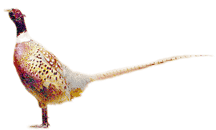|
 |
|||||||||
|
||||||||||
|
||||||||||
Letter from South DakotaThe pheasant capital of the worldThe lush field stretched almost as far as I could see as we paused for our hunting party to re-gather the line abreast. Held back by the thigh-high switchgrass and rye, those in the denser areas took a few moments to catch up, their blaze-orange hats and shoulder patches in stark contrast with the milder hues of the expansive South Dakota prairie. On the opposite flank, about 150 yards away, I could see my friend Rick Carty as he recalled his dog, Harley, a young German shorthair pointer feverishly working a patch of birdy-looking cover. Sophie, my own shorthair, was already circling back, wondering why I wasn’t following her anxious lead. In the middle of the field, the dark, loping silhouettes of two Labrador retrievers were re-joining our guides. Suddenly, halfway to me, Sophie locked into an intense point. Holding my old 20-gauge superposed at port arms, my thumb tensing on the safety, I moved in her direction. Pointers are not an ideal dog for hunting pheasants, as the birds don’t often hold. If the hunter is slow in reaching the dog, as often as not the bird will have vacated the premises. Scanning the grasses, I was on full alert as I advanced. Two steps later, a thunderous explosion of wings sent my adrenaline level into the stratosphere. There is no preparing yourself from the spectacular flush of a ring-necked pheasant. Knowing it is nearby only increases the sensory overload that this game bird causes in every hunter who has ever pursued it. This time I got lucky; my first shot sent the bird tumbling. Hastily reloading, I hurried to reach it. Pheasants are exceedingly tough, and any delay in getting to a downed bird is ill advised. Thus the second cock-bird that burst out as I passed by caught me unprepared. I turned and shouldered my gun. The bright rooster rocketed up and away … and I missed it cleanly with both barrels. The smugness of my earlier marksmanship evaporated faster than the profile of the departing bird. Off to the other side, I could hear the amused comments of my other hunting companions, Mike Kelly and Charlie Nieman, as they critiqued my errant shooting. It was well deserved, but of course I was used to it. Missing a South Dakota ringneck happens pretty often to everyone who hunts them.
Becoming AmericanThe ring-necked or Chinese pheasant is not a native to our continent. It is of Asian origin, but it has been with us almost since the birth of our nation. George Washington is said to have been the first to bring this magnificent avian strain to our shores in the late 1700s. But it was Judge Owen Denny, a sportsman and the first American consul to Shanghai, China, who established a thriving population in Oregon in 1881. The bird immediately spread throughout middle America, preferring particularly the rich grasslands and fertile farms of the prairie states. By just 1924, the first game census in South Dakota estimated over a million resident birds; the rest of the Midwestern states were not far behind. Pheasant numbers continued to grow, but the national Soil Bank Program initiated in 1956 sent the population soaring. Intended as a stabilizing influence on crop production and a soil-conservation inducement, the program returned over 29 million acres of agricultural land to grassland. The effect on pheasants was exponential. By 1958, 11 million birds were estimated in North Dakota alone. The program expired in 1960, and as the grasslands gradually went back to agricultural production, pheasants declined as well. In 1985, the Conservation Reserve Program reinitiated land protection efforts. By 2006, the game census revealed that the bird counts were once again approaching the levels of the golden years. South Dakota was at the heart of the resurgence. South Dakota is KingLater that day, with our full limit of birds dressed and refrigerated, we relaxed with our hosts and guides, Bob and Frank Smith, at their hunting and fishing resort at Lake Oahe on the Missouri River in Gettysburg, South Dakota (www.Bobsresort.com or 605-765-2500). We revisited the incredible numbers of birds we had encountered during the week, and they agreed it was indeed a return to the good old days. Bob’s has been in operation for almost 50 years, ever since their dad, Bob Smith, began building the resort and started guiding hunters and anglers to the fish and wildlife riches found in the vast areas of their sparsely populated state (780,000 people; 350,000 square miles). Both Bob and Frank have experienced the full extent of the fluctuations of game bird numbers over those years. Even when the South Dakota pheasant hunting has been bad, it’s been rather spectacular. That’s why South Dakota is called the Pheasant Capital of the World. Note to HuntersMaryland Department of Natural Resources in years past attempted to establish a population of ring-necked pheasant in Maryland. However, mineral compositions essential to the bird’s reproduction are generally unavailable in the state’s ecosystems. Maryland still has a pheasant season, but few birds are found outside the pen-reared pheasants of regulated shooting areas. |
||||||||||
|
||||||||||
|
|
||||||||||
|
© COPYRIGHT 2007 by New Bay Enterprises, Inc. All rights reserved. |
||||||||||

